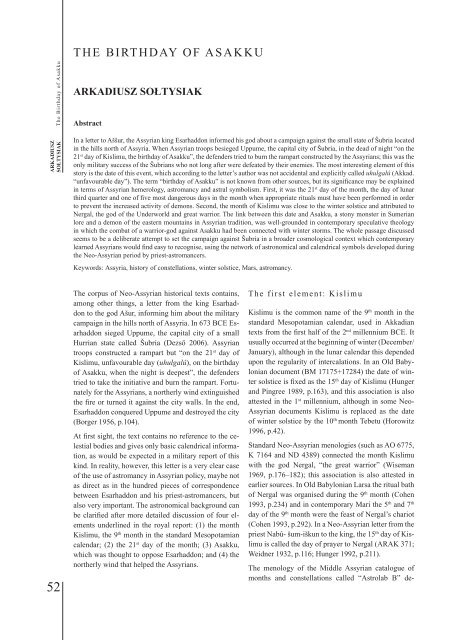BALTICA10
BALTICA10
BALTICA10
You also want an ePaper? Increase the reach of your titles
YUMPU automatically turns print PDFs into web optimized ePapers that Google loves.
THE BIRTHDAY OF ASAKKU<br />
ARKADIUSZ<br />
SOŁTYSIAK The Birthday of Asakku<br />
ARKADIUSZ SOŁTYSIAK<br />
Abstract<br />
In a letter to Aššur, the Assyrian king Esarhaddon informed his god about a campaign against the small state of Šubria located<br />
in the hills north of Assyria. When Assyrian troops besieged Uppume, the capital city of Šubria, in the dead of night “on the<br />
21 st day of Kislimu, the birthday of Asakku”, the defenders tried to burn the rampart constructed by the Assyrians; this was the<br />
only military success of the Šubrians who not long after were defeated by their enemies. The most interesting element of this<br />
story is the date of this event, which according to the letter’s author was not accidental and explicitly called uhulgalû (Akkad.<br />
“unfavourable day”). The term “birthday of Asakku” is not known from other sources, but its significance may be explained<br />
in terms of Assyrian hemerology, astromancy and astral symbolism. First, it was the 21 st day of the month, the day of lunar<br />
third quarter and one of five most dangerous days in the month when appropriate rituals must have been performed in order<br />
to prevent the increased activity of demons. Second, the month of Kislimu was close to the winter solstice and attributed to<br />
Nergal, the god of the Underworld and great warrior. The link between this date and Asakku, a stony monster in Sumerian<br />
lore and a demon of the eastern mountains in Assyrian tradition, was well-grounded in contemporary speculative theology<br />
in which the combat of a warrior-god against Asakku had been connected with winter storms. The whole passage discussed<br />
seems to be a deliberate attempt to set the campaign against Šubria in a broader cosmological context which contemporary<br />
learned Assyrians would find easy to recognise, using the network of astronomical and calendrical symbols developed during<br />
the Neo-Assyrian period by priest-astromancers.<br />
Keywords: Assyria, history of constellations, winter solstice, Mars, astromancy.<br />
52<br />
The corpus of Neo-Assyrian historical texts contains,<br />
among other things, a letter from the king Esarhaddon<br />
to the god Ašur, informing him about the military<br />
campaign in the hills north of Assyria. In 673 BCE Esarhaddon<br />
sieged Uppume, the capital city of a small<br />
Hurrian state called Šubria (Dezső 2006). Assyrian<br />
troops constructed a rampart but “on the 21 st day of<br />
Kislimu, unfavourable day (uhulgalû), on the birthday<br />
of Asakku, when the night is deepest”, the defenders<br />
tried to take the initiative and burn the rampart. Fortunately<br />
for the Assyrians, a northerly wind extinguished<br />
the fire or turned it against the city walls. In the end,<br />
Esarhaddon conquered Uppume and destroyed the city<br />
(Borger 1956, p.104).<br />
At first sight, the text contains no reference to the celestial<br />
bodies and gives only basic calendrical information,<br />
as would be expected in a military report of this<br />
kind. In reality, however, this letter is a very clear case<br />
of the use of astromancy in Assyrian policy, maybe not<br />
as direct as in the hundred pieces of correspondence<br />
between Esarhaddon and his priest-astromancers, but<br />
also very important. The astronomical background can<br />
be clarified after more detailed discussion of four elements<br />
underlined in the royal report: (1) the month<br />
Kislimu, the 9 th month in the standard Mesopotamian<br />
calendar; (2) the 21 st day of the month; (3) Asakku,<br />
which was thought to oppose Esarhaddon; and (4) the<br />
northerly wind that helped the Assyrians.<br />
The first element: Kislimu<br />
Kislimu is the common name of the 9 th month in the<br />
standard Mesopotamian calendar, used in Akkadian<br />
texts from the first half of the 2 nd millennium BCE. It<br />
usually occurred at the beginning of winter (December/<br />
January), although in the lunar calendar this depended<br />
upon the regularity of intercalations. In an Old Babylonian<br />
document (BM 17175+17284) the date of winter<br />
solstice is fixed as the 15 th day of Kislimu (Hunger<br />
and Pingree 1989, p.163), and this association is also<br />
attested in the 1 st millennium, although in some Neo-<br />
Assyrian documents Kislimu is replaced as the date<br />
of winter solstice by the 10 th month Tebetu (Horowitz<br />
1996, p.42).<br />
Standard Neo-Assyrian menologies (such as AO 6775,<br />
K 7164 and ND 4389) connected the month Kislimu<br />
with the god Nergal, “the great warrior” (Wiseman<br />
1969, p.176–182); this association is also attested in<br />
earlier sources. In Old Babylonian Larsa the ritual bath<br />
of Nergal was organised during the 9 th month (Cohen<br />
1993, p.234) and in contemporary Mari the 5 th and 7 th<br />
day of the 9 th month were the feast of Nergal’s chariot<br />
(Cohen 1993, p.292). In a Neo-Assyrian letter from the<br />
priest Nabû- šum-iškun to the king, the 15 th day of Kislimu<br />
is called the day of prayer to Nergal (ARAK 371;<br />
Weidner 1932, p.116; Hunger 1992, p.211).<br />
The menology of the Middle Assyrian catalogue of<br />
months and constellations called “Astrolab B” de-
















